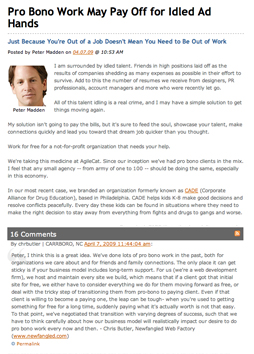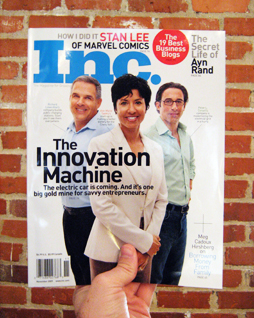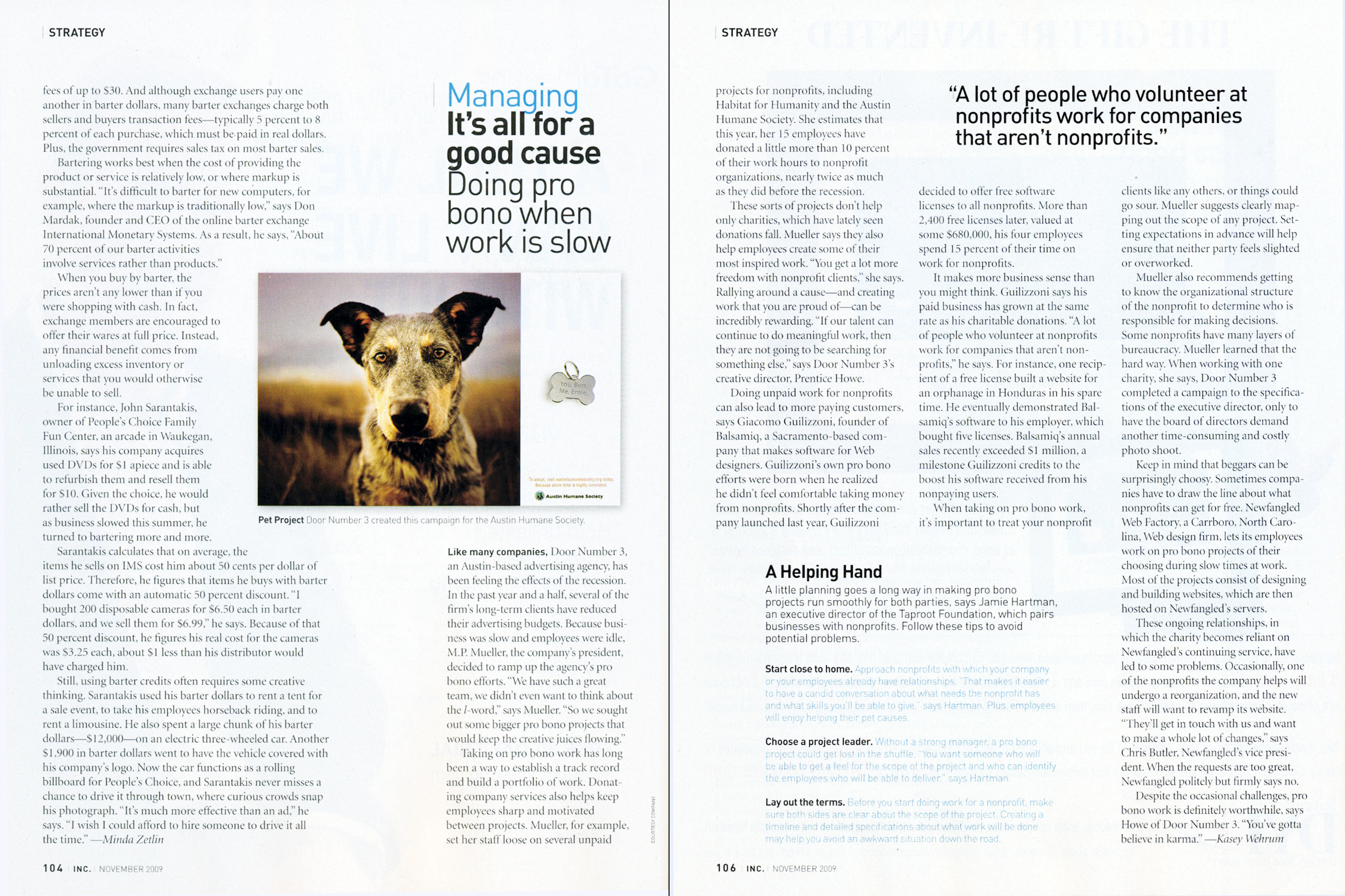
My Opinion: No, You Shouldn’t
Back in early April, I read a post by Peter Madden on the Advertising Age “Small Agency Diary” blog about the benefits of doing pro-bono work during the idle time brought on by an economic recession (pictured in the screenshot to the left). What I think Peter was really trying to hone in on was the idea that though doing pro-bono work may have its good, altruistic purposes, it can also be a practical means to keeping minds and faculties productive and busy when they’d be otherwise unused. I completely agree with that sentiment; for a designer, staying in practice is well worth the investment. However, I did comment on his post in order to note one reservation I would have- I’ve copied my comment below:
“Peter, I think this is a great idea. We’ve done lots of pro bono work in the past, both for organizations we care about and for friends and family connections. The only place it can get sticky is if your business model includes long-term support. For us (we’re a web development firm), we host and maintain every site we build, which means that if a client got that initial site for free, we either have to consider everything we do for them moving forward as free, or deal with the tricky step of transitioning them from pro-bono to paying client. Even if that client is willing to become a paying one, the leap can be tough- when you’re used to getting something for free for a long time, suddenly paying what it’s actually worth is not that easy. To that point, we’ve negotiated that transition with varying degrees of success, such that we have to think carefully about how our business model will realistically impact our desire to do pro bono work every now and then.”
Journalists Love a Good Debate
I was a bit nervous about potentially being seen as a naysayer. After all, the predominant tone of the marketing industry in the current social media era is one of sharing and generosity. Amidst that, who would want to be perceived as a Scrooge? As you’ll see if you read through the comment string, there were opinions on all sides.

Then, in September, I received a call from Kasey Wehrum, writer for Inc. Magazine. He’d seen my comment on the AdAge blog while doing research for a piece he was writing on the benefits of pro-bono work for November’s issue and wanted to ask me some questions about our experience and pull some quotes for his article. We spoke for about thirty minutes or so, during which I stressed that though we’ve done much pro-bono work due to existing relationships with various causes that employees have had, the notion of using pro-bono work as a strategy to build business was never one we adopted for two reasons: (1) Doing so would be contrary to any consultant’s positioning. If consultants choose to give away advice, it should be because they truly care about the cause. Doing so with the expectation that it could be turned profitable would be disingenuous. (2) When your primary deliverable is incorporeal (advice, strategy, direction, etc.), getting a client to start paying for that kind of service after they’ve already been receiving it for free is very, very difficult- even if they say they are willing.
Requisite Benefits-of-Social-Media Interlude
I should point out that this scenario is a great example of the unplanned serendipity of social media. It’s become a habit of mine to actively engage with other blogs in my industry, so it wasn’t unusual for me to share my opinion on the AdAge blog. What was unusual, to me at least, is that the post that I had commented on, and indeed my comment itself, became research material for a journalist at a major publication. I was glad to share my opinion and experience with Kasey Wehrum, who was a pleasure to speak with, but was surprised that I might be of any help to him. There must be others more qualified than I. However, having commented immediately on Peter Madden’s post put me in the right place at the right time.
Still a Naysayer
As it turns out, the article took a different direction from what I thought it was going to be about. It’s titled Using Charitable Donations to Motivate Employees. Wehrum uses an example of a software company which built an offering for a pro-bono client and was then able to demo it to another company which became a paying customer. Pro-pro-bono, but no problem there- I think my point still stands when it comes to consultative work. In any case, the remaining reference to our conversation was disappointing:
“Keep in mind that beggars can be surprisingly choosy. Sometimes companies have to draw the line about what nonprofits can get for free. Newfangled Web Factory, a Carrboro, North Carolina, Web design firm, lets its employees work on pro bono projects of their choosing during slow times at work. Most of the projects consist of designing and building websites, which are then hosted on Newfangled’s servers.
These ongoing relationships, in which the charity becomes reliant on Newfangled’s continuing service, have led to some problems. Occasionally, one of the nonprofits the company helps will undergo a reorganization, and the new staff will want to revamp its website. “They’ll get in touch with us and want to make a whole lot of changes,” says Chris Butler, Newfangled’s vice president. When the requests are too great, Newfangled politely but firmly says no.”
Oh well. We’re really not Scrooges here at Newfangled! I did leave a clarifying comment, which I hope won’t be seen as overly defensive:
“One point I’d want to clarify is this: In the past when we’ve chosen to do pro-bono work, it has been because we’ve believed in the cause, not in order to gain a potential paying client at some later point.
When it comes to service-oriented firms and consultants, transitioning a pro-bono client to a paying client is very difficult as you’ve already been giving them your best advice for free. For any agency, this should be a serious consideration when entertaining the strategy of getting a foot in the door by offering free service. However, if the scope of the offering has been limited to implementation only (i.e. a website), there could definitely be potential to expand the scope of your service when the client is able to pay.
Also, we do politely say no once the client’s need exceeds our ability to subsidize it, but we also almost always connect them to someone else who can help them.”
Here’s a scan of the article. Click to open it in full size:



